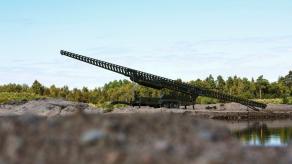At the Armiya-2024 forum in Russia, the Kronstadt company will hold a presentation of its new jet attack drone project, named Grom, russian federal media report. This unmanned aerial vehicle (UAV) is designed to carry air-launched precision-guided weapons, including the Kh-31 anti-radar missile.
Other details on the Grom project besides its primary purpose are currently limited, but it is reported to have a maximum payload capacity of 2,000 kilograms, sufficient for launching guided air-to-surface missiles.
Read more: russian Capture of Ukrainian Magura Sea Drone Exposes Enemy’s Missteps

Visually, the Grom resembles the Tu-300 Korshun, a jet attack UAV developed in the 1990s with a design based on the Soviet Tu-141 Strizh reconnaissance UAV.
To put it shortly, the Tu-300 Korshun project was an attempt to adapt the Strizh into a multirole platform capable of carrying unguided aerial bombs or classic reconnaissance equipment, but it never advanced beyond the conceptual stage.
The failure of the Tu-300 Korshun was largely due to the inability of its developers at the Tupolev Design Bureau to convincingly demonstrate how the drone would be configured for suspension of weapons and launch while carrying them to potential customers from the Russian Ministry of Defense.

Despite these issues encountered in the past, it is likely that the Kronstadt company has drawn on the Tu-300 project as a foundation for the Grom UAV. But here's where the problems start.
First of all, the Grom will face competition from the S-70 Okhotnik developed by Sukhoi. As a project in the same niche, the S-70 offers much more, although its development has been delayed numerous times, so does the planned date to begin its mass production.
Another challenge is the cost-effectiveness of the Grom. For instance, Ukraine used to repurpose existing Tu-141 Strizh drones for strikes, utilizing available units from stock. Producing new UAVs from scratch takes much more resources. Meanwhile, the combat effectiveness of such aircraft in a warzone like Ukraine has been underwhelming ever since it transitioned to a positional warfare, heavily saturated with air defenses.
Read more: Capabilities of the Tu-141 Strizh Converted Into a Cruise Missile














